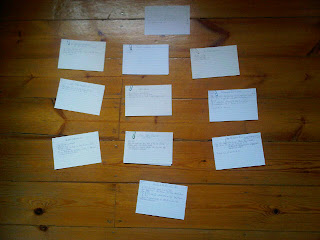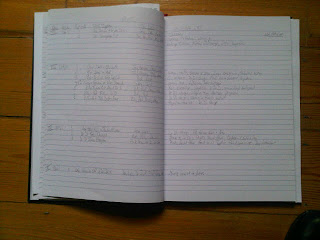I’m committed to sharing the process of writing Novel 3 with you all. I already wrote about diving into the first draft and some tips I have remembered here. But now I find that I have entered a new mini phase that I want to discuss.
I have indeed written over 20,000 words in a very short time and before I went any further, my editor and I decided it would be best to take a breath and take a look at what I was doing and how I was doing it. She’s a wise woman, that editor of mine. Luckily, things seem to be going well. I’m now fairly convinced that my scheme for alternating 1st and 3rd person chapters will work. But there is a trap that I am teetering on the brink of falling into. I need to forget that A Clash of Innocents was ever written. Novel 3 will share some characters with that book, and it will also be set in Cambodia, although in a different part of the country. So although it will complement Clash, it will not be a sequel. You will not need to have read Clash first and, indeed, I can imagine that many will enter this world I’m creating through Novel 3 and then go on to read Clash after. That means I have to beware of the temptation to give updates on what my characters had been doing during the intervening time between the two books. I have to make sure I slowly introduce the characters just as I did before, without assuming that the reader has any prior knowledge. I have to let the story and the characters unfold at their own pace without interrupting them with flashbacks or too many interior monologues or semiconscious reminiscences. And I think we found a way for me to do that.
Although I had plotted out the book to an extent before I started writing, the framework was a bit nebulous. I basically knew where I was going, but the pace was unclear and I didn’t always understand what was going to follow what. So I have done something which I actually love to do — I’ve brought out the index cards! My, how I love index cards. They’re so neat, so tidy, so compactly there. And this is what I’ve done:
* On each card I wrote the name of one possible episode. Underneath, I wrote some notes about what would happen and who it would happen to. For example, one card says: Srey and Fred walk to Clinic for First Time Then underneath I wrote (1) Description of street scene, women selling etc (2) street people tease Srey, misunderstanding who she is and who is Fred
* After doing that, I found I had 34 cards. I then began my favourite part: the index card shuffle. I grouped the cards according to theme, time frame etc until I had 10 stacks, each stack representing a chapter.
* Within each stack, I put the cards in order so that one episode followed another. Then I wrote one more card serving as an overview of how many chapters, what each chapter is generally about and, to make sure the chapters aren’t too lopsided, the number of episodes (so far) in each chapter. And here they are:
Now for Plot Plotting Step 2. In my notebook, spread across two pages, I made a chart with seven columns: Chapter. Voice (because they alternate a bit). Episode. What Happens. To Whom. Themes. Word Count/# of Pages.
For each chapter, I filled out the chart listing each episode. This serves two purposes, firstly to help my increasingly failing memory to remember what happened where. But more importantly, it allows me to actually see where the climaxes fall, where troubles are introduced and resolved, where characters are included. In other words, it sets up the pacing, which is crucial. And the chart looks like this (actually, there are 3 spreads of these):
So there you have it, my Plot Plotting all done and dusted. Now, of course, I have to be flexible, allowing myself to make changes, shuffle things around, add and delete. But I can do that easily because everything is written in pencil and I bought myself an excellent new eraser — of course, every big task needs a purchasing opportunity.
I know that some novelists out there may be horrified by this and I’m not saying that this incredibly anal approach is for everyone. It is actually based on a format called the Snowflake Method, which I posted about here. But it works for me, and now I’m ready to start writing again, methodically making my way from episode to episode, and knowing that with my plot structure in place, I can allow my imagination to go as wild as it wants, within the 6″x4″ parameters of each index card’s notes.


So fascinating to see another writer’s process at work – thanks Sue – and how wonderful to be able to bounce ideas of you editor at this stage. You share working methods with one Tracy Chevalier – I went to a talk at Charleston a few years back, Chevalier and another writer, Salley Vickers (Miss Garnet’s Angel) discussing their work.
They were complete opposites. Chevalier, like you, works to a carefully planned outline, the results of months of work and research. The whole is on a series of index cards, in something like a shoebox – each scene, in order, broken down into who needs to talk to who, what room, how – what happens and when.
In this way she told us, she can pick out any index card from the box, and write what is on it – depending on the time available, and her mood – a deliacate exchange. A blockbuster scene. A description of setting. Until the book is done, to first draft.
Vickers was the opposite. She set a character who fascinated her free on a journey, not knowing why, or what, when or who…just the roughest of endings that rose up about half way through and she worked towards it by pointing her character at that ending, and following her.
So different!
Celebrate that difference.
I’m a planner Sue, but you put me to shame! I think that’s fascinating. I think it must really help you to understand your work better too. Though I plan, I often stumble upon what I’m actually doing while I write, sometimes I don’t see clearly until I do edits, and others not until the book is out. Fantastic! and thanks for sharing your Plot Plotting.
Now you’re like me. I always make up words, very important sounding words that appear to people as if I know what I’m doing but it’s more about explaining it to myself: Plot Map, the Organic Method, Fiction Tension. I fear all sorts of new writers will march forth into the world with my made up words only to be told they don’t exist. 🙂